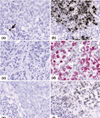Lack of evidence for an association of Epstein-Barr virus infection with breast carcinoma
- PMID: 12559053
- PMCID: PMC154138
- DOI: 10.1186/bcr561
Lack of evidence for an association of Epstein-Barr virus infection with breast carcinoma
Abstract
Background: Epstein-Barr virus (EBV) is a ubiquitous human gamma-herpes virus infecting more than 90% of the population worldwide. EBV is associated with certain malignancies (e.g. Burkitt lymphoma, Hodgkin lymphoma and nasopharyngeal carcinoma). Recent studies have raised the possibility that EBV may also be involved in the pathogenesis of breast carcinoma, the most common carcinoma of females. If substantiated, this finding would have major implications regarding prevention and therapy of the disease. The studies published so far have employed diverse methods, however, and the results have been controversial.
Methods: Using the EBV DNA PCR, EBV DNA in situ hybridisation and in situ hybridisation for the detection of the EBV-encoded RNAs, and using immunohistochemistry for the demonstration of the EBV-encoded nuclear antigen 1, we have studied a series of 59 invasive breast carcinomas for evidence of EBV infection.
Results: EBV-encoded RNA-specific in situ hybridisation and EBV-encoded nuclear antigen 1 immunohistochemistry were negative in all cases. Using the PCR, EBV DNA was detected in four out of 59 cases. These cases were further studied by EBV DNA in situ hybridisation, showing an absence of viral DNA from the tumour cells.
Conclusion: These results indicate that breast carcinoma is not an EBV-associated tumour.
Figures

Comment in
-
Lack of evidence for an association of Epstein-Barr virus infection with breast carcinoma--another point of view.Breast Cancer Res. 2003;5(4):E6; author reply E7. doi: 10.1186/bcr599. Breast Cancer Res. 2003. PMID: 12817996 Free PMC article. No abstract available.
References
-
- International Agency for Research on Cancer Epstein–Barr Virus and Kaposi's Sarcoma Herpesvirus/Human Herpesvirus 8 Lyon: World Health Organisation. 1997.
-
- Labrecque LG, Barnes DM, Fentiman IS, Griffin BE. Epstein–Barr virus in epithelial cell tumors: a breast cancer study. Cancer Res. 1995;55:39–45. - PubMed
-
- Bonnet M, Guinebretiere J-M, Kremmer E, Grunewald V, Benhamou E, Contesso G, Joab I. Detection of Epstein–Barr virus in invasive breast cancers. J Natl Cancer Inst. 1999;91:1376–1381. - PubMed
-
- Ambinder RF, Robertson KD, Moore SM, Yang J. Epstein–Barr virus as a therapeutic target in Hodgkin's disease and nasopharyngeal carcinoma. Semin Cancer Biol. 1996;7:217–226. - PubMed
-
- Sing AP, Ambinder RF, Hong DJ, Jensen M, Batten W, Petersdorf E, Greenberg PD. Isolation of Epstein–Barr virus (EBV)-specific cytotoxic T lymphocytes that lyse Reed–Sternberg cells: implications for immune-mediated therapy of EBV+ Hodgkin's disease. Blood. 1997;89:1978–1986. - PubMed
Publication types
MeSH terms
Substances
LinkOut - more resources
Full Text Sources
Medical

